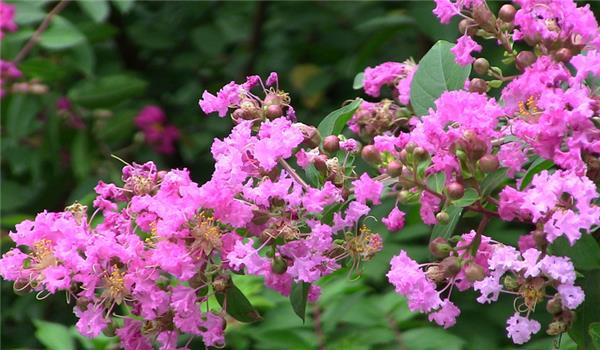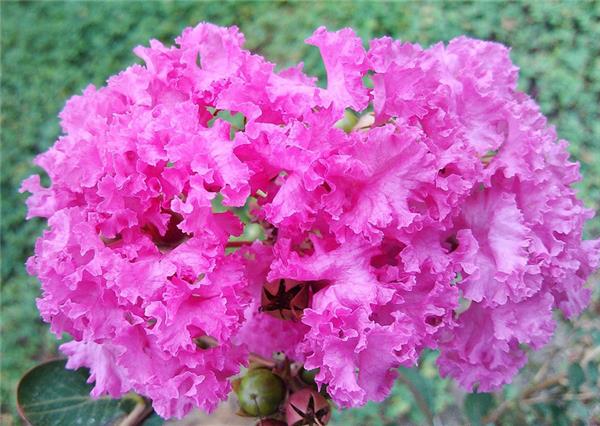Culture methods and matters needing attention of crape myrtle
Crape myrtle flowers are colorful, beautiful, long flowering period, is a more common flowering plants, and can purify the air, so a lot of places are planted, let's take a look at crape myrtle culture methods and points for attention.

Culture methods and matters needing attention of crape myrtle
Soil: crape myrtle has strong vitality, easy to cultivate and lax requirements on soil, but it grows best in deep and fertile sandy loam. Crape myrtle flowers avoid waterlogging, avoid planting in low wet places with high groundwater level.
Watering: crape myrtle has a great demand for water in the growing season and needs to keep the soil moist. Keep the basin soil moist in spring and east, and water each in the morning and evening in summer and autumn. In case of high temperature, you can increase the frequency of watering. It is necessary to do a good job in drainage during the rainy season to prevent the water from rotting. It is not suitable to water in autumn.
Sunshine: crape myrtle flowers like light, lack of light is not only few or no flowering plants, and even weak growth, small branches and leaves. Therefore, it is necessary to put the crape myrtle in the outdoor sunshine during the growing season.
Fertilization: crape myrtle is a fertilizer-loving plant, lack of fertilizer will lead to thin branches, yellow color, resulting in weaker growth, less or no flowering, but too much fertilization will lead to excessive growth of branches and leaves. Can be fertilized every year after the defoliation of crape myrtle flowers in winter and before germination in spring, such as the application of human feces and urine or sesame sauce residue is better, can make crape myrtle flowers grow exuberantly in the coming year, the flowers are big and colorful.

Pruning: crape myrtle has strong branching power and large shoot growth, so it is very resistant to pruning. Crape myrtle flowers should be cut off after flowering, which can prolong the flowering period, and some cross branches, diseased branches and radiation branches should be cut off in time so as not to consume excess nutrients. At the same time, in order to beautify the shape, the plump terminal buds of other branches are generally truncated 1 inch above the top bud, keeping about 5 meters.
Insect pests: the common pests of crape myrtle flower are velvet scale, yellow thorn moth, big coir moth and so on. Attention should be paid to pesticide control.
Note: if potted crape myrtle flowers should be changed in time, potted crape myrtle flowers need to change basin soil every two to three years, and culture soil is mixed with 5% loose mountain soil, 3% pastoral soil and 2% fine river sand. when changing the basin, you can use bone powder, bean cake powder and other organic fertilizer as the base fertilizer, mixed in the soil surface, can not make fertilizer direct contact with the root system, so as not to burn the root system, affecting plant growth.

Propagation methods of crape myrtle
1. Grafting propagation of crape myrtle
From late February to early March, before the sprouting of crape myrtle branches. When grafting, the sturdy seedlings were selected as rootstocks, the branches of the desired flowers and colors were taken as scions, and the split grafting method was adopted. The scion with more than 2 buds is cut into a wedge after a longitudinal split at the top of the rootstock with a depth of about 5 "8" m, and then inserted into the split of the rootstock to aim at the cambium. Then wrap the whole spike branch with plastic film to reveal the bud. Using this method, different color branches were grafted on the same rootstock to form a multi-color tree.
2. Crape myrtle hardwood cuttings
It is usually carried out before the branches germinate from mid-late March to early April. Select sturdy annual branches, cut into cuttings with 15cm length, insert them into loose and well drained sandy loam seedbeds, and cut deep to expose the uppermost bud of cuttings. After insertion, pour through water and cover with plastic film to keep moisture and heat preservation. When the seedling grows into 15-20 cm, the film can be lifted, changed into a shade net, and watered at the right time, and the branches can grow to about 60-80 m in the same year.
3. Crape myrtle twig cuttings
It was carried out from July to August, when the new branches grew vigorously and had the most vitality. Select semi-lignified branches and cut them into cuttings with 8~10cm length, leaving 2 or 3 leaves at the top. The insertion depth is 3~4cm. After insertion, pour through water, and build a shade shed to shade, generally take root in about 20 days, remove the film, retain the shade net, and then timely watering, the branches can grow to about 60-80 cm in that year, and the survival rate is very good.

4. Crape myrtle striping propagation
Striping propagation can be carried out in the whole growing season of crape myrtle, especially from March to April in spring. Air pressing method can choose 1-2-year-old branches, cut with a sharp knife and peel the bark around 1.5 cm, expose the xylem, and apply the rooting powder solution (diluted according to the instructions) to about 3 cm above the burn site. After drying, use a barrel-shaped plastic bag to cover the cut, fill it with loose garden soil, tie both ends tightly after watering, and check after a month. If the soil is too dry, it can be watered and moisturized, and cut off after rooting.
5. Crape myrtle meristem propagation
The tiller seedlings germinated in the rhizosphere of the plant were dug out with roots from March to early April or autumn, and the roots and branches were properly trimmed and planted separately. Seedlings can be bare roots, large seedlings should bring mud balls, tending should be often pruned, plastic, maintain a beautiful tree shape, promote flower branches to flourish.
6. Sowing and propagation of crape myrtle
From November to December, collect the mature seeds, remove the pericarp, dry the seeds slightly, and store them in a container. In March of the following year, the seedling bed of sandy soil was sown or sown with broad banners, covered with a layer of fine charred mud, with no seeds and covered with grass. After more than 10 days of germination, the grass can be uncovered in time, and the seedlings can be selected after rain when two pairs of true leaves appear in the seedlings; weeding frequently in the seedling stage, applying thin fertilizer 2 or 3 times from June to July, irrigation and drought prevention in summer, the seedling height at the end of the year is about 40-50 square meters, and the strong growth can be cut off in time, and the Spring Equinox will transplant and grow up the next year. A large number of strong and neat seedlings can be obtained by sowing and breeding at one time.
Fill it with loose garden soil, tie it tightly at both ends after watering, check after a month, if the soil is too dry, replenish water and moisturize, cut off another plant after rooting.
5. Crape myrtle meristem propagation
The tiller seedlings germinated in the rhizosphere of the plant were dug out with roots from March to early April or autumn, and the roots and branches were properly trimmed and planted separately. Seedlings can be bare roots, large seedlings should bring mud balls, tending should be often pruned, plastic, maintain a beautiful tree shape, promote flower branches to flourish.
6. Sowing and propagation of crape myrtle
From November to December, collect the mature seeds, remove the pericarp, dry the seeds slightly, and store them in a container. In March of the following year, the seedling bed of sandy soil was sown or sown with broad banners, covered with a layer of fine charred mud, with no seeds and covered with grass. After more than 10 days of germination, the grass can be uncovered in time, and the seedlings can be selected after rain when two pairs of true leaves appear in the seedlings; weeding frequently in the seedling stage, applying thin fertilizer 2 or 3 times from June to July, irrigation and drought prevention in summer, the seedling height at the end of the year is about 40-50 square meters, and the strong growth can be cut off in time, and the Spring Equinox will transplant and grow up the next year. A large number of strong and neat seedlings can be obtained by sowing and breeding at one time.
Related
- Wuhan Hospital Iron Tree Blooming Result Was Instantly Frightened by the Gardener Master
- Which variety of camellia is the most fragrant and best? Which one do you like best?
- What is the small blue coat, the breeding methods and matters needing attention of the succulent plant
- Dormancy time and maintenance management of succulent plants during dormancy
- Minas succulent how to raise, Minas succulent plant pictures
- What are the varieties of winter succulent plants
- How to raise succulent plants in twelve rolls? let's take a look at some experience of breeding twelve rolls.
- Attention should be paid to water control for succulent plants during dormant period (winter and summer)
- Watering experience of twelve rolls of succulent plants
- Techniques for fertilizing succulent plants. An article will let you know how to fertilize succulent plants.



